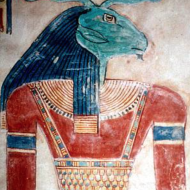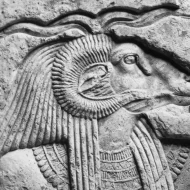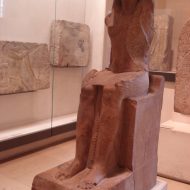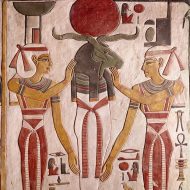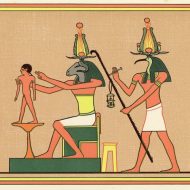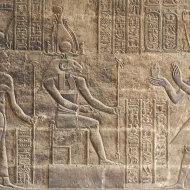Khnum : The Fertility God
Listen
At a glance
| Description | |
|---|---|
| Origin | Egyptian Mythology |
| Classification | Gods |
| Family Members | Neith, Menhit, Nebtuwi, and Heka (Wives) |
| Region | Egypt |
| Associated With | Fertility, Nile, Pottery, Birth |
Khnum
Introduction
The Egyptian god of fertility, Khnum, was also known as Khnemu. He was worshipped during the 1st dynasty, and during the early centuries CE, he was depicted as either a man with a ram’s head or a ram with horizontal horns. It is believed that he created humans using clay and a potter’s wheel.
The god’s first major cult center was Herwer, which was located near Al-Ashmūnayn in Egypt. During the New Kingdom, from which he emerged, he was the deity of Elephantine, which is located near Aswan. He was regarded as the god of the Nile River and formed a trio of deities with Anukis and Satis.
Physical Traits
As a god of fertility, Khnum was typically depicted as either a man with a ram’s head or a ram with horizontal horns. He was often depicted wearing a white crown, which represented his authority over Egypt. He was also known to hold an ankh and a scepter.
He was often depicted as either a ram-headed man or a full-bodied male with a plumed white crown in Upper Egypt. During the early years of history, he was shown as the first known domesticated ram, which had long horizontal horns that grew from its head. Unfortunately, this species died out, and he was still regarded as a type of sheep until the later periods of Egyptian history.
He was eventually depicted as the Ovis platyra, which is a type of ram that’s associated with Amun. He was sometimes depicted with four ram heads, and he was referred to as Sheft-hat. He was often aligned with the sun god Re, as well as the earth god Geb and the god of the dead Osiris.
Family
In the pyramid inscriptions, Khnum was mentioned as a god of fertility. Before the Re cult became popular, the pyramid builder Khufu’s cult was very popular. His grandsons Khafra and Menkaura, who added the word “Re” to their names, were the next pyramid builders.
It’s believed that he was the protector of the Nile, but he became a helper of Hapi. He was also responsible for releasing the right amount of silt into the water during the flooding. Because of his work with the silt, he became a great potter, and he molded various deities.
Pottery was made using the Nile’s soil, and it was believed that he made the first humans and the gods using his potter’s wheel. In Iunyt, it was stated that he molded the egg that the sun laid upon. He was regarded as the father of all the deities and the creator of everything that’s created.
Other names
Khnum’s name means “the builder” or “the molder” in ancient Egyptian. It is also spelled as Khnemu, Khnoumis, or Chnoubis in different sources. His name was written with a hieroglyph of a ram’s head, which was his main animal form.
Powers and Abilities
The god was believed to have created humans and animals through the potter’s wheel, and he was also associated with various other natural phenomena, such as the Nile River. It’s believed that he was able to control the yearly flooding of the river, which brought abundance and fertility to the land. Khnum was regarded as the protector of the Nile or the lord of the cataract area. Because of his association with the life-giving mud and water, he was depicted as a potter who created humans using his wheel. In addition, it’s believed that he and the goddess Heqet helped with the birth of a child.
The Egyptians believed that the powerful power of the ram was a vital factor in turning the god into a creator god, and some writings also claimed that he created the other deities. Khnum is often referred to as the “ba” or “man” of Re, which is a physical manifestation of the sun god as he was depicted as a man with a ram’s head as he walked through the underworld.
Modern Day Influence
As the populatrity of Khnum faded overtime with teh growth of other gods like Ra and Osiris during the Later dynasty, there has been very little mention of the god in modern pop culture.
Related Images
Frequently Asked Questions
What is the Khnum god of?
Is Khnum the same as Ra?
Though separate Egyptian gods, Khnum and Ra are intertwined. Khnum, the ram-headed god of creation, was seen as the sculptor of humanity and even Ra himself. His link to the Nile’s life-giving floods further connected him to the sun god Ra. Over time, their roles overlapped, with Khnum sometimes representing the evening sun, blurring the lines between creator and radiant deity.
Who is the Greek equivalent of Khnum?
While Egyptian and Greek religions differed, there’s no single Greek god mirroring Khnum. For creation, Greeks looked to Gaia (Earth) or primordial forces. For fertility, Aphrodite played a role. Khnum’s connection to the Nile might be vaguely echoed by Poseidon, god of the sea. It’s best to understand Khnum within the context of Egyptian mythology.
What does Khnum mean in English?
The word “Khnum” itself doesn’t have a direct translation in English. It’s an ancient Egyptian name for a specific deity. However, the Egyptian word khnem (related to Khnum’s name) later evolved into a verb meaning “to shape” or “to build” in Egyptian language. This reflects Khnum’s association with creation and shaping humanity from clay.
Did Khnum have a wife?
Khnum wasn’t alone in his divine duties. He had a wife, most commonly Heqet, the goddess of fertility. Together, they symbolized the creation of life, with Khnum shaping bodies on his potter’s wheel and Heqet breathing life into them. In some areas, other goddesses like Nebt-uu (fertility) or Menhit (war and creation) were seen as his consorts.

